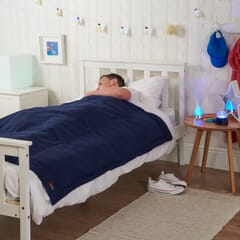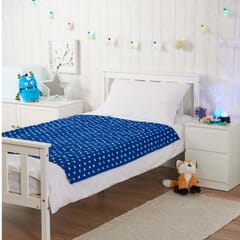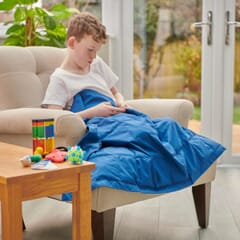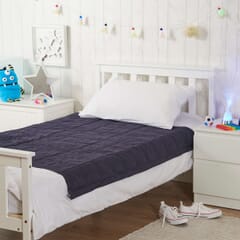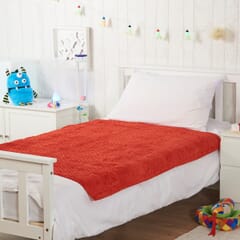Get exclusive deals you won't find anywhere else straight to your inbox.
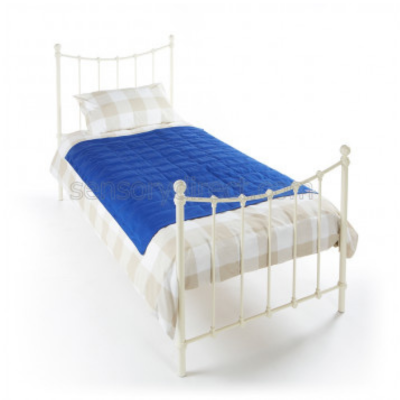
Do Weighted Blankets Actually Work?
In the 10 years that Sensory Direct has been making weighted blankets this is the question we get asked more than any other. The question most commonly comes from parents of children with Autism seeking a night’s sleep but can also come from OTs or adults with conditions ranging from ASD to restless leg syndrome to Tourette’s.
The only honest answer I usually give people is “It might!”
This is not always what people want to hear but the truth is that you won’t really know until you’ve tried a weighted blanket out. There are however some signs that you can look out for:
Does your child:
- Seek out deep pressure? Some sensory seekers will engage in activities that give deep pressure sensory experiences such as rough play, tight hugs, piling cushions on top of themselves etc.
- Find it difficult to sit still? Many sensory seekers have a need to be constantly on the go, finding it difficult to sit in one place for any length of time, have a need to fidget.
- Like to sleep under a lot of bedclothes, or do they pile books onto themselves at night or prefer to sleep in a sleeping bag? I have even heard of children who will sleep underneath their mattress
If you recognise some or all of these signals, then a weighted blanket may be beneficial in helping your child to be calmer and possibly sleep better. There are no guarantees but in my experience these are a good indication – particularly the final point.
If you are still not sure there a couple of things you can try out before you invest in a weighted blanket:
- Let your child sleep in a “mummy” style sleeping bag. Add a sheet over the top and tuck it in tightly. Although there is no weight, this will provide a sense of security and some deep pressure and will give you some indication as to whether deep pressure is a viable solution.
- Put a heavy old blanket (such as a picnic blanket) over your child’s normal bedclothes – you could also add a thick heavy coat (such as a sheepskin coat). Do this when your child goes to bed – (but DON’T leave these on them as they are likely to overheat!) If your child is verbal ask them how it feels – if not gauge their reaction to having weight on them. If they like the feeling and find it comforting then a weighted blanket will probably work for them.
Even after trying out these things and observing the signs you still may not be sure. With prices starting at £100 a weighted blanket is not cheap – particularly if it’s not going to be effective. That is why Sensory Direct offer a no quibble 60 day return policy on all weighted blankets. Try a weighted blanket for 60 days and if it does not work simply let us know and return it to us (conditions apply – please visit our website for full details).
Which weighted blanket should I buy and how heavy should it be?
We make several types of weighted blanket:
- Classic Weighted Blanket – this has the weight sewn into small cells in the blanket which makes it ideal for day and night. The blanket moulds itself to the body and is great for wrapping across the shoulders. Measures 140cm x 110cm
- Adjustable Weighted Blanket – comes with the weights in pockets so you can add weight as your child grows. Comes in 2 sizes – standard 150cm x 120cm and large 200cm x 135cm
- Midi Weighted Blanket - this is suitable for younger children sleeping in a smaller bed or for adults to use as deep pressure around their shoulders or on their lap. Measures 110cm x 90cm
- Snuggly Tactile Weighted Blanket - this is reversible with soft & snuggly fabric on one side and polycotton on the other. It is made from a soft, warm and cosy dimple fleece fabric. It has a great tactile feel and gives a calming hug effect. Measures 138cm x 106cm
- Fleece Weighted Blanket - this is reversible with fleece on one side and polycotton on the other. Measures 138cm x 106cm
- Wipe Clean Fire Retardant Blanket - measures 138cm x 106cm
We have a wide range of colours and covers available for weighted blankets.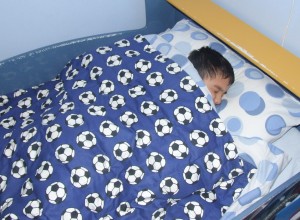
What weight?
The most common generally accepted principle is to buy a weighted blanket that is 10% of the user’s bodyweight. So for example a child weighing 30kgs the correct weight would be a 3kg weighted blanket. In the 10 years we have been making weighted blankets this is the weight we have found to be heavy enough to be effective but not too heavy to be a potential hazard. We would always recommend consulting with your OT regarding blanket weights.
Are weighted blankets safe?
Used sensibly and by following a few simple guidelines, weighted blankets are a perfectly safe and effective sensory tool. Many thousands of families, schools and homes safely use a weighted blanket every day and every night.
Guidelines:
- The weighted blanket should not exceed the 10% of users bodyweight
- Always make sure the user can self-remove the weighted blanket if necessary
- Do not use the weighted blanket as a restraint
- Do not cover the face with the weighted blanket
- Check the user on a regular basis and discontinue usage at the first sign of any discomfort.
For more information please visit www.sensorydirect.com
© Copyright Andrew Caws 2015.


